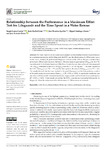Mostrar o rexistro simple do ítem
Relationship between the Performance in a Maximum Effort Test for Lifeguards and the Time Spent in a Water Rescue
| dc.contributor.author | López García, Sergio | |
| dc.contributor.author | Ruibal-Lista, Brais | |
| dc.contributor.author | Palacios-Aguilar, José | |
| dc.contributor.author | Santiago-Alonso, Miguel | |
| dc.contributor.author | Prieto Saborit, José Antonio | |
| dc.date.accessioned | 2021-04-05T17:10:45Z | |
| dc.date.available | 2021-04-05T17:10:45Z | |
| dc.date.issued | 2021-03-25 | |
| dc.identifier.citation | López-García, S.; Ruibal-Lista, B.; Palacios-Aguilar, J.; Santiago-Alonso, M.; Prieto, J.A. Relationship between the Performance in a Maximum Effort Test for Lifeguards and the Time Spent in aWater Rescue. Int. J. Environ. Res. Public Health 2021, 18, 3407. https://doi.org/10.3390/ ijerph18073407 | es_ES |
| dc.identifier.issn | 1660-4601 | |
| dc.identifier.uri | http://hdl.handle.net/2183/27657 | |
| dc.description.abstract | [Abstract] The main objective of this study was to analyse the relationship between the performance in a maximum incremental test for lifeguards, the IPTL, and the effectiveness of a 200 m water rescue on the beach. Initially, 20 professional lifeguards carried out the IPTL in the pool and then they performed a 200 m water rescue on the beach. The maximum oxygen uptake (VO2max) in the IPTL was estimated. In both tests, heart rate (HR), blood lactate (La) and time achieved were measured. The VO2max estimated in the IPTL (VO2IPTL) was 44.2 - 4.7 mL_kg_min 1, the time reached in the IPTL (TimeIPTL) was 726_72 s and the time spent in the rescue (TimeRescue) was 222_14 s. The results showed that the time reached in the pool (TimeIPTL) was the best predictor varieble of the performance in water rescue (TimeRescue) (R2 = 0.59; p < 0.01). A significant correlation was also observed between the estimated maximum oxygen uptake and the beach rescue performance (R2 = 0.37; p = 0.05). These results reveal that the iPTL, a maximum incremental test specific to lifeguards, allows the estimation of the effectiveness of a 200 m rescue on the beach. | es_ES |
| dc.language.iso | eng | es_ES |
| dc.publisher | MDPI AG | es_ES |
| dc.relation.uri | https://doi.org/10.3390/ijerph18073407 | es_ES |
| dc.rights | Atribución 4.0 Internacional | es_ES |
| dc.rights.uri | http://creativecommons.org/licenses/by/4.0/ | * |
| dc.subject | Water rescue | es_ES |
| dc.subject | Physical fitness | es_ES |
| dc.subject | Lifesaving | es_ES |
| dc.subject | Performance | es_ES |
| dc.subject | Drowning | es_ES |
| dc.subject | Rescate acuático | es_ES |
| dc.subject | Aptitude física | es_ES |
| dc.subject | Salvamento | es_ES |
| dc.subject | Rendemento | es_ES |
| dc.subject | Afogamento | es_ES |
| dc.subject | Aptitud física | es_ES |
| dc.subject | Rendimiento | es_ES |
| dc.subject | Ahogamiento | es_ES |
| dc.subject | VO2max | es_ES |
| dc.title | Relationship between the Performance in a Maximum Effort Test for Lifeguards and the Time Spent in a Water Rescue | es_ES |
| dc.type | info:eu-repo/semantics/article | es_ES |
| dc.rights.access | info:eu-repo/semantics/openAccess | es_ES |
| UDC.journalTitle | International Journal of Environmental Research and Public Health | es_ES |
| UDC.volume | 18 | es_ES |
| UDC.issue | 7 | es_ES |
| dc.identifier.doi | 10.3390/ijerph18073407 |
Ficheiros no ítem
Este ítem aparece na(s) seguinte(s) colección(s)
-
GI-AA - Artigos [4]
-
GI-INCIDE - Artigos [16]






